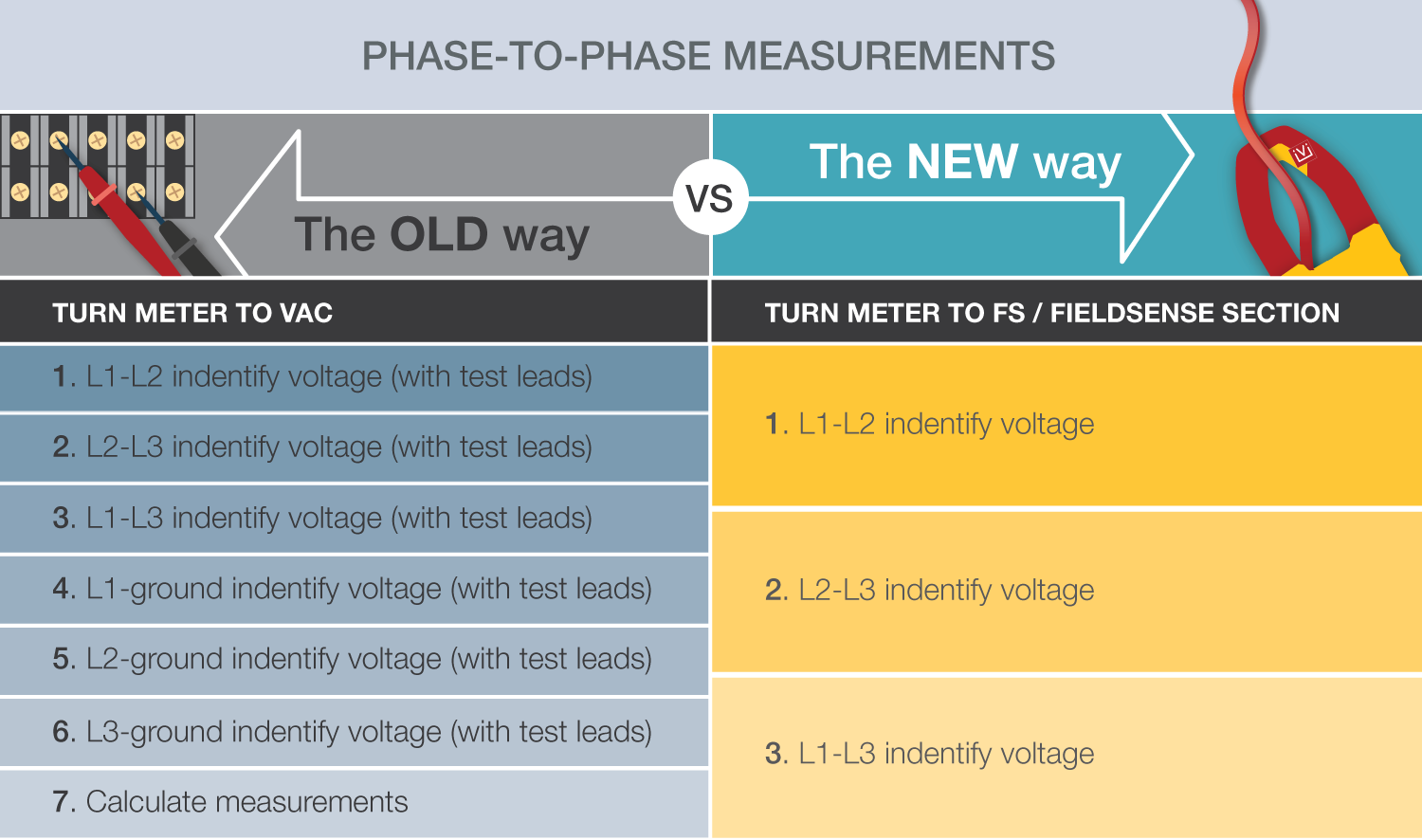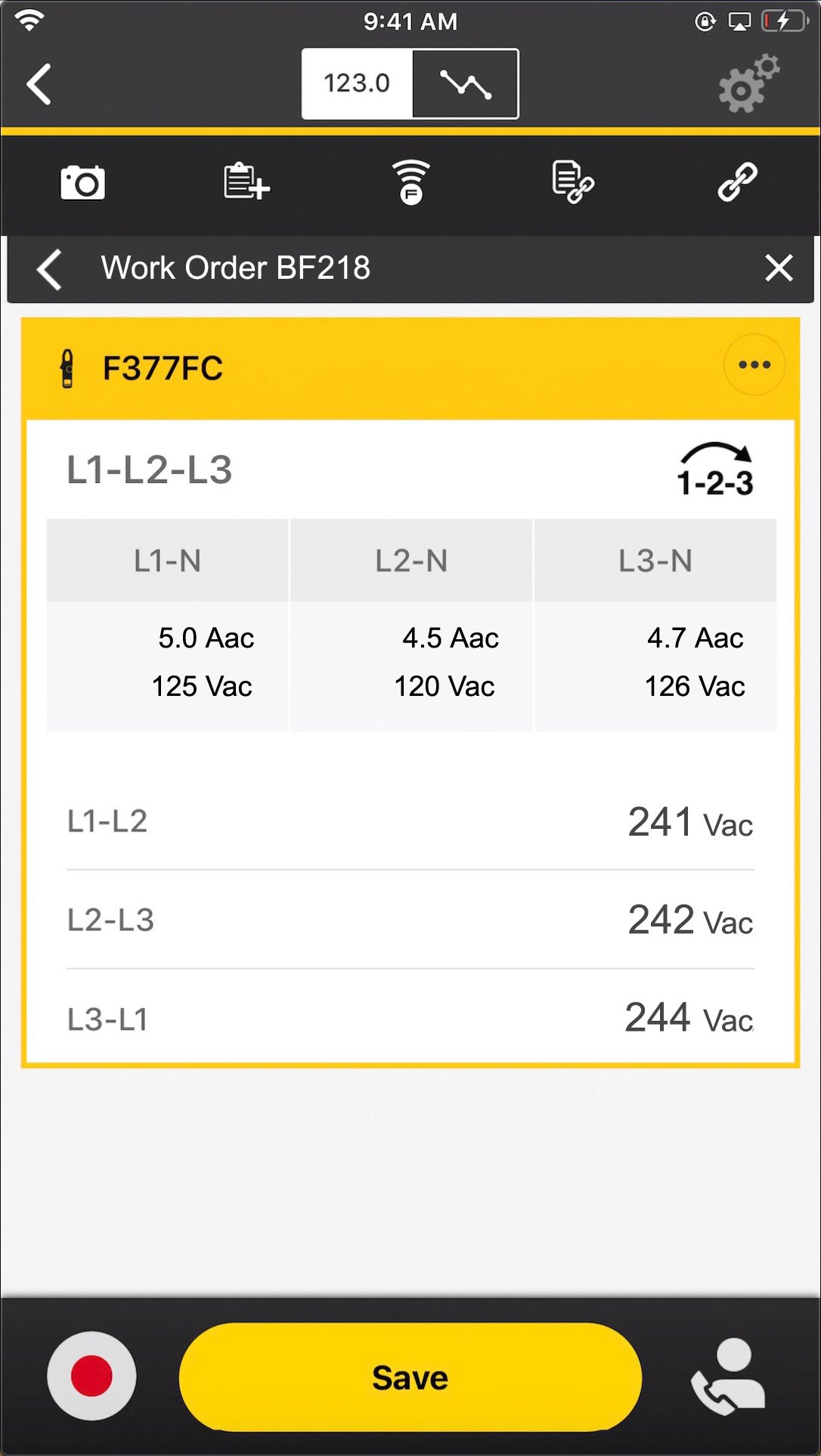Complete three-phase voltage and current measurements 50% faster*
The Fluke 377 FC and 378 FC Clamp Meters are the first handheld clamps with Fieldsense™ technology where voltage and current can be measured simultaneously with the clamp jaw. Meaning, these clamp meters can be used to make sequential line-to-ground measurements and current measurements that result in calculated line-to-line voltage measurements and phase rotation information. These measurements are an indication that the three-phase system is working as expected.
Phase-to-phase measurements simplified
L1, L2, and L3 (or Line 1, Line 2, and Line 3) are commonly used naming conventions for the wires in three-phase alternating current (AC) systems. On three-phase loads, voltage and current need to be measured sequentially using leads.
The current ‘Select-Measure-Write, Select-Measure-Write’ workflow is time-consuming. It requires you to repeat these steps for all three phases. It also creates a need for a third-hand or an additional person to help with connecting the two leads and clamping on the conductor while writing values.
The Fluke 377 FC and 378 FC revolutionizes the process for measuring voltage and current in three phase power systems. Instead of needing to make each measurement individually with test leads and calculate by hand, you only need to make three measurements with the clamp. Then, the meter auto-calculates the full set of phase-to-phase voltages based on the phase-to-ground measurements. These clamps come with a dual-display screen allowing simultaneous measurement and display of voltage and amperage.

How to make a three-phase measurement
To setup
- Turn the control knob to
 (Fieldsense™)
(Fieldsense™) - Connect the clamp to ground with the ground lead
- Push MIN MAX for 2 seconds. Now the Clamp is in line-to-line mode and L1-L2-L3 shows on the display.
To test
- Position the clamp jaw around the first conductor. Wait for the measurement on the screen to settle. The screen will turn green, beep, and L1 will be displayed.
- Move the clamp jaw to the second conductor within 10 seconds. Wait for the measurement on the screen to settle. You will hear a beep and L2 will be displayed.
- Move the clamp jaw to the last conductor within 10 seconds. Wait for the measurement on the screen to settle. You will hear a beep and L3 will be displayed.
To calculate
When the L1-L2-L3 measurements are complete, use the clamp to calculate the total voltage between each pair of conductors:
- Push MIN MAX once: screen shows the total voltage between L1 and L2.
- Push MIN MAX again: screen shows the total voltage between L2 and L3.
- Push MIN MAX a third time: screen shows the total voltage between L3 and L1.
While in the line-to-line mode, you can review each line-to-ground measurement:
- Push MIN MAX again to show the L1 measurement.
- Push MIN MAX again to show the L2 measurement.
- Push MIN MAX again to show the L3 measurement.
To review L1-L2-L3 measurements, continue to push the ‘MIN MAX’ button and scroll through the measurements.
To exit the line-to-line mode, hold the ‘MIN MAX’ button for about 2 seconds.


Phase Rotation Indicator
One of the biggest needs when dealing with three-phase equipment is knowing the correct phase order and then ensuring work is done in the proper order during installation, maintenance, and troubleshooting. On top of simplifying the measurement process, the Fluke 377 FC and 378 FC also auto-calculates the phase rotation. All you have to do is make all three three-phase measurements while connected to the Fluke Connect (FC) app, then the phase rotation is auto-calculated and shown on the FC app.
Applications
Installation of HVAC motor and compressor
Determine if the load per phase is balanced and phase rotation is correct during installation. An unbalanced three-phase system will cause poor performance or premature failure of a motor, leading to expensive downtime. Unbalance can occur at any point throughout the distribution system. Loads should be divided equally across each phase of the incoming feeder circuits. Motors or compressors fed by an unbalanced system will run hotter and eventually suffer premature failure.
Troubleshooting three-phase motors
Identify when a fuse is blown on a phase, resulting in phase loss. With phase loss, the other two phases will draw more current, which will overheat the windings of the pump, motor, or compressor. By measuring the phase of the incoming line voltage, users can determine which phase is down and help prevent damage to the equipment. If phase loss occurs when the equipment is running, overheating will begin as the load is pulled from the other phases. If the equipment has stopped, then it will not restart until the fuse is replaced and all three phases exist again.
*Beta tests conducted at customer sites show time taken for three phase measurements reduces by 50%. (Fieldsense™)
(Fieldsense™)